Find Trade Colleges
Emergency Medical Technology/Technician (EMT Paramedic)
Types of Degrees Emergency Medical Technology/Technician (EMT Paramedic) Majors Are Getting
The following table lists how many emergency medical technology/technician (emt paramedic) graduations there were in 2021-2022 for each degree level.
| Education Level | Number of Grads |
|---|---|
| Basic Certificate | 17,349 |
| Undergraduate Certificate | 5,811 |
| Associate Degree | 3,686 |
| Bachelor’s Degree | 372 |
What Emergency Medical Technology/Technician (EMT Paramedic) Majors Need to Know
People with careers related to emergency medical technology/technician (emt paramedic) were asked what knowledge areas, skills, and abilities were important for their jobs. They weighted these areas on a scale of 1 to 5 with 5 being the highest.
Knowledge Areas for Emergency Medical Technology/Technician (EMT Paramedic) Majors
This major prepares you for careers in which these knowledge areas are important:
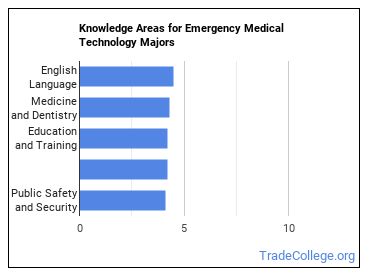
- English Language - Knowledge of the structure and content of the English language including the meaning and spelling of words, rules of composition, and grammar.
- Medicine and Dentistry - Knowledge of the information and techniques needed to diagnose and treat human injuries, diseases, and deformities. This includes symptoms, treatment alternatives, drug properties and interactions, and preventive health-care measures.
- Education and Training - Knowledge of principles and methods for curriculum and training design, teaching and instruction for individuals and groups, and the measurement of training effects.
- Customer and Personal Service - Knowledge of principles and processes for providing customer and personal services. This includes customer needs assessment, meeting quality standards for services, and evaluation of customer satisfaction.
- Public Safety and Security - Knowledge of relevant equipment, policies, procedures, and strategies to promote effective local, state, or national security operations for the protection of people, data, property, and institutions.
Skills for Emergency Medical Technology/Technician (EMT Paramedic) Majors
emergency medical technology/technician (emt paramedic) majors are found most commonly in careers in which the following skills are important:
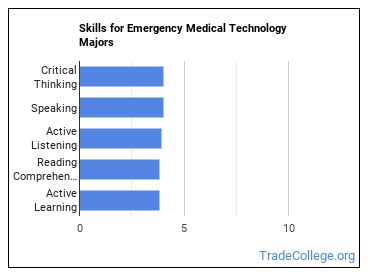
- Critical Thinking - Using logic and reasoning to identify the strengths and weaknesses of alternative solutions, conclusions or approaches to problems.
- Speaking - Talking to others to convey information effectively.
- Active Listening - Giving full attention to what other people are saying, taking time to understand the points being made, asking questions as appropriate, and not interrupting at inappropriate times.
- Reading Comprehension - Understanding written sentences and paragraphs in work related documents.
- Active Learning - Understanding the implications of new information for both current and future problem-solving and decision-making.
Abilities for Emergency Medical Technology/Technician (EMT Paramedic) Majors
Some of the most crucial abilities to master while a emergency medical technology/technician (emt paramedic) student include the following:
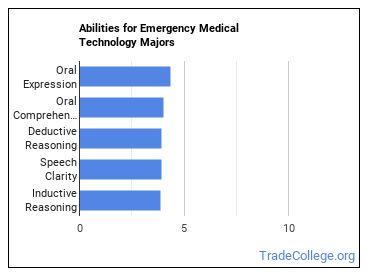
- Oral Expression - The ability to communicate information and ideas in speaking so others will understand.
- Oral Comprehension - The ability to listen to and understand information and ideas presented through spoken words and sentences.
- Deductive Reasoning - The ability to apply general rules to specific problems to produce answers that make sense.
- Speech Clarity - The ability to speak clearly so others can understand you.
- Inductive Reasoning - The ability to combine pieces of information to form general rules or conclusions (includes finding a relationship among seemingly unrelated events).
What Can You Do With a Emergency Medical Technology/Technician (EMT Paramedic) Major?
People with a emergency medical technology/technician (emt paramedic) degree often go into the following careers:
| Job Title | Job Growth Rate | Median Salary |
|---|---|---|
| Emergency Medical Technicians and Paramedics | 15.1% | $34,320 |
Other Related Emergency Medical Technology Programs
Learn about start dates, transferring credits, availability of financial aid, and more by contacting the universities below.
Take your associate degree in an allied health field to the next level with this specialized transfer friendly online bachelor of science from Southern New Hampshire University.
Who Is Getting an Associate’s Degree in Emergency Medical Technology/Technician (EMT Paramedic)?
Racial-Ethnic Diversity
At the countrywide level, the racial-ethnic distribution of emergency medical technology/technician (emt paramedic) majors is as follows:
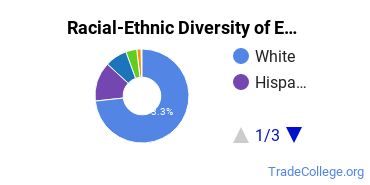
| Race/Ethnicity | Number of Grads |
|---|---|
| Asian | 46 |
| Black or African American | 157 |
| Hispanic or Latino | 602 |
| White | 2,601 |
| International Students | 18 |
| Other Races/Ethnicities | 262 |
Geographic Diversity
Students from other countries are interested in Emergency Medical Technology/Technician (EMT Paramedic), too. About 0.5% of those with this major are international students.
How Much Do Emergency Medical Technology/Technician (EMT Paramedic) Majors Make?
Salaries According to BLS
Average salaries range from $37,760 to $122,320 (25th to 75th percentile) for careers related to emergency medical technology/technician (emt paramedic). This range includes all degree levels, so you may expect those with a more advanced degree to make more while those with less advanced degrees will typically make less.
To put that into context, according to BLS data from the first quarter of 2020, the typical high school graduate makes between $30,000 and $57,900 a year (25th through 75th percentile). The average person with a bachelor’s degree (any field) makes between $45,600 and $99,000. Advanced degree holders make the most with salaries between $55,600 and $125,400.
Amount of Education Required for Careers Related to Emergency Medical Technology/Technician (EMT Paramedic)
Some degrees associated with emergency medical technology/technician (emt paramedic) may require an advanced degree, while others may not even require a bachelor’s in the field. In general, the more advanced your degree the more career options will open up to you. However, there is significant time and money that needs to be invested into your education so weigh the pros and cons.
Find out what the typical degree level is for emergency medical technology/technician (emt paramedic) careers below.
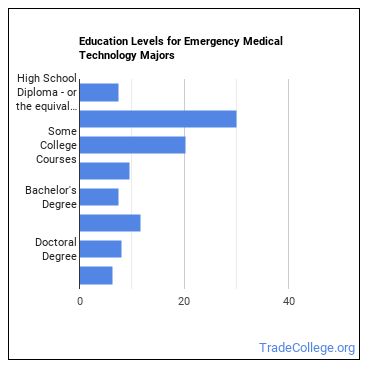
| Education Level | Percentage of Workers |
|---|---|
| High School Diploma - or the equivalent (for example, GED) | 7.5% |
| Post-Secondary Certificate - awarded for training completed after high school (for example, in agriculture or natural resources, computer services, personal or culinary services, engineering technologies, healthcare, construction trades, mechanic and repair technologies, or precision production) | 30.0% |
| Some College Courses | 20.4% |
| Associate’s Degree (or other 2-year degree) | 9.5% |
| Bachelor’s Degree | 7.4% |
| Master’s Degree | 11.7% |
| Doctoral Degree | 8.1% |
| Post-Doctoral Training | 6.2% |
Online Emergency Medical Technology/Technician (EMT Paramedic) Programs
The following table lists the number of programs by degree level, along with how many schools offered online courses in the field.
| Degree Level | Colleges Offering Programs | Colleges Offering Online Classes |
|---|---|---|
| Certificate (Less Than 1 Year) | 0 | 0 |
| Certificate (1-2 years) | 443 | 2 |
| Certificate (2-4 Years) | 5 | 0 |
| Associate’s Degree | 513 | 7 |
| Bachelor’s Degree | 4 | 1 |
| Post-Baccalaureate | 0 | 0 |
| Master’s Degree | 3 | 2 |
| Post-Master’s | 0 | 0 |
| Doctor’s Degree (Research) | 0 | 0 |
| Doctor’s Degree (Professional Practice) | 0 | 0 |
| Doctor’s Degree (Other) | 0 | 0 |
Is a Degree in Emergency Medical Technology/Technician (EMT Paramedic) Worth It?
The median salary for a emergency medical technology/technician (emt paramedic) grad is $37,760 per year. This is based on the weighted average of the most common careers associated with the major.
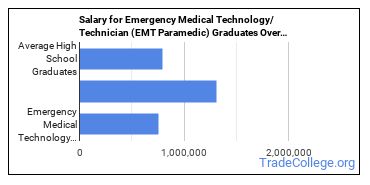
Explore Major by State
Alabama
California
District of Columbia
Idaho
Kansas
Maryland
Mississippi
Nevada
New York
Oklahoma
South Carolina
Utah
West Virginia
Alaska
Colorado
Florida
Illinois
Kentucky
Massachusetts
Missouri
New Hampshire
North Carolina
Oregon
South Dakota
Vermont
Wisconsin
Trades Related to Emergency Medical Technology/Technician (EMT Paramedic)
You may also be interested in one of the following majors related to emergency medical technology/technician (emt paramedic).
References
*The racial-ethnic minorities count is calculated by taking the total number of students and subtracting white students, international students, and students whose race/ethnicity was unknown. This number is then divided by the total number of students at the school to obtain the racial-ethnic minorities percentage.
- College Factual
- College Scorecard
- National Center for Education Statistics
- O*NET Online
- U.S. Bureau of Labor Statistics
- Usual Weekly Earnings of Wage and Salary Workers First Quarter 2020
More about our data sources and methodologies.

